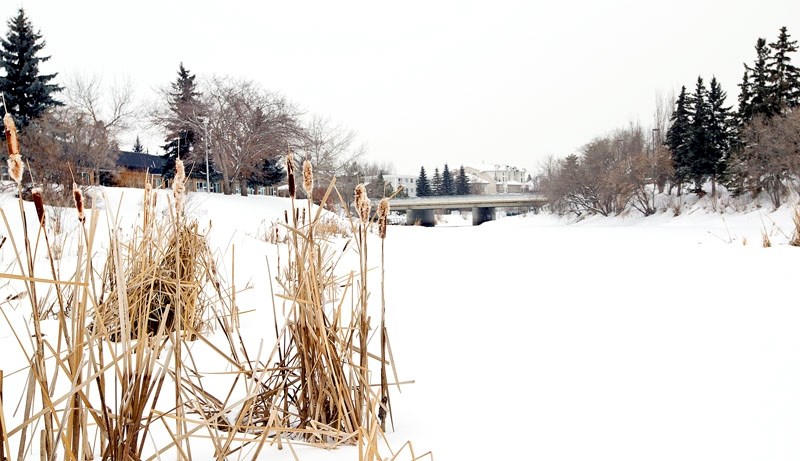A new study suggests that residents are ready and willing to help protect the Sturgeon River – if they knew how. About 30 people came to St.
A new study suggests that residents are ready and willing to help protect the Sturgeon River – if they knew how.
About 30 people came to St. Albert Place Wednesday night to hear the results of a survey done by the Sturgeon River Research Project group.
Run by the Northern Alberta Institute of Technology (NAIT), the survey asked about 384 people about the state of the Sturgeon watershed. It’s considered accurate to within five percentage points, and was sponsored by the Alberta Rural Development Network and the Alberta Conservation Association.
About 38 per cent of respondents were from St. Albert, said Milad Asdaghi, a consultant attached to the survey.
The survey asked respondents about their perceptions of the Sturgeon watershed, particularly how it had changed in the last 15 years.
Rosalind Shepherd, who has lived near Lac Ste. Anne for about 64 years, says there was hardly a home or cottage to be found on its shores when she was a child.
Now, the place is crowded with them. “Much of the riparian areas have been destroyed,” she said, replaced with beaches and lawns that leach fertilizer and chemicals into the lake. “The number of water birds has greatly diminished,” she added, as had the number and diversity of fish.
About 40 to 44 per cent of respondents said that the number, diversity and size of fish caught in the Sturgeon had decreased over their lifetime, the survey found. About a third perceived similar drops in mammal and bird populations, but another third felt there was no change.
Neil Martindale, who grew up in St. Albert, said kids regularly swam and fished in the Sturgeon back in 1981. “I don’t think anyone would swim in that area anymore.”
Respondents were less likely to use the Sturgeon for recreational activities today than they did 15 years ago, Asdaghi said, with all uses save for walking and bird-watching in decline. This could be due to the high proportion of seniors who responded to the survey, he noted.
Still, Asdaghi said he was shocked to see that about 46 per cent of respondents said they fished in the Sturgeon River 15 years ago. “That’s now down to 19.6 per cent. That’s a pretty significant decline.”
Fish populations are in decline in almost all Alberta lakes, noted Laurie Hunt, one of the two NAIT biologists heading up the Sturgeon River Research Project, which could explain part of this drop.
“There’s definitely been a shift in the community of fish,” she added – suckers and stickleback had replaced walleye and lake sturgeon – which would also discourage fishing. This shift suggests a decline in water quality.
About 62 per cent of respondents found that water quality of rivers in the Sturgeon watershed was poor, Asdaghi said, with about 57 per cent saying the water levels were poor as well.
NAIT research did find signs of poor water quality in the watershed such as low oxygen and high phosphorous levels, reported Debbie Webb, the other biologist heading up the Sturgeon research project.
The river is much better during the spring, Webb noted, and improves once you get past St. Albert. “It’s a shallow, slow-flowing Prairie system. It’s not going to be a pristine mountain river ever, but there is room for improvement.”
Respondents said the most important issue related to the health of the Sturgeon was the need for a watershed management plan, with about 66 per cent ranking it as very important. The most helpful step to protect the watershed would be to limit development in highly sensitive areas, the survey found.
The survey also found a strong demand for public education on river issues, Webb noted. “It looks like a willingness to help out if they knew what to do.”
The study’s top recommendation was for municipalities to work together on a watershed management plan. This echoes the top recommendation of the 2012 State of the Sturgeon River Report, which called for the creation of a municipal Sturgeon River watershed group.
We can start by setting some measurable goals, Martindale said, such as the return of certain fish species. “Let’s see walleye in St. Albert again.”
We should also expose our youth to nature and encourage residents to monitor their watershed as citizen scientists, Shepherd said. “Let’s give people some voice.”
The research team hoped to present the study’s results to local governments, Hunt said, and work with residents to restore riparian zones. A full report would be available in about a month.
Another open house on the study will be held at the Sturgeon County office in Morinville on Feb. 4 from 1 to 3 p.m. Call Hunt at 780-378-2856 for details.
